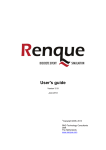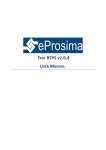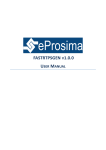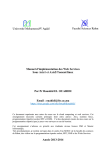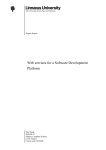Download User`s Manual
Transcript
eProsima RPC over REST User Manual Version 0.3.0 The Middleware Experts eProsima © 2014 1 eProsima Proyectos y Sistemas de Mantenimiento SL Ronda del poniente 2 – 1ºG 28760 Tres Cantos Madrid Tel: + 34 91 804 34 48 [email protected] – www.eProsima.com Trademarks eProsima is a trademark of Proyectos y Sistemas de Mantenimiento SL. All other trademarks used in this document are the property of their respective owners. License eProsima RPC over REST is licensed under the terms described in the RPCREST_LICENSE file included in this distribution. Technical Support Phone: +34 91 804 34 48 Email: [email protected] 2 Contents 1 Introduction....................................................................................................................5 1.1 A quick example.......................................................................................................5 1.2 Main features...........................................................................................................6 2 Building an application...................................................................................................7 2.1 Defining a set of remote procedures.......................................................................7 2.2 WADL syntax and mapping to IDL and C++............................................................11 2.2.1 Simple parameter types..................................................................................11 2.2.2 Parameter definition.......................................................................................11 2.2.3 Representation definition...............................................................................13 2.2.4 Method definition...........................................................................................15 2.2.5 Resource definition.........................................................................................16 2.2.6 Resources definition........................................................................................16 2.2.7 Application definition......................................................................................16 2.2.8 Example...........................................................................................................17 2.3 Generating specific remote procedure call support code.....................................17 2.3.1 RPCRESTGEN command syntax.......................................................................17 2.3.2 Server side.......................................................................................................18 2.3.3 Client side........................................................................................................18 2.4 Server implementation..........................................................................................18 2.4.1 API...................................................................................................................19 2.4.2 Example...........................................................................................................19 2.5 Client implementation...........................................................................................20 2.5.1 API...................................................................................................................20 2.5.2 Example...........................................................................................................20 3 Advanced concepts.......................................................................................................22 3.1 Network transports................................................................................................22 3.1.1 HTTP Transport................................................................................................22 3.2 Threading server strategies....................................................................................23 3.2.1 Single thread strategy......................................................................................23 3.2.2 Thread Pool strategy.......................................................................................24 3.2.3 Thread per request strategy............................................................................24 4 Hello World example....................................................................................................26 4.1 Writing the WADL file.............................................................................................26 3 4.2 Generating specific code........................................................................................26 4.3 Client implementation...........................................................................................27 4.4 Server implementation..........................................................................................28 4.5 Build and execute...................................................................................................28 4 1 Introduction eProsima RPC over REST is a high performance remote procedure call (RPC) framework. It combines a software stack with a code generation engine to build services that will efficiently work in several platforms and programming languages. REST (Representational State Transfer) is an architectural style consisting of a coordinated set of constraints applied to components, connectors, and data elements, within a distributed hypermedia system. One can characterise RESTful applications by conforming them with the REST principals and constraints. eProsima RPC over REST supports RESTful as the communication engine to transmit the remote procedure call requests and replies. 1.1 A quick example You write a .WADL file like this: <application xmlns="http://wadl.dev.java.net/2009/02"> <resources base="http://example.com/"/> <resource path="Example"> <method name="GET" id="exampleMethod" /> </resource> </resources> </application> Then you process the file with the rpcrestgen compiler to generate C++ code. Afterwards, you use that code to invoke RESTful resources with the client proxy: ProxyTransport *transport = new HttpProxyTransport(“http://example.com”); ExampleProtocol *protocol = new ExampleProtocol(); ExampleResourceProxy *proxy = new ExampleResourceProxy(*transport, *protocol); ... proxy->exampleMethod(); or to implement a server using the generated skeleton: HttpServerTransport *transport = new HttpServerTransport(“http://example.com”); ExampleProtocol *protocol = new ExampleProtocol(); SingleThreadStrategy *single = new SingleThreadStrategy(); ExampleResourceServerImpl servant; ExampleResourceServer *server = new ExampleResourceserver(*single, *transport, *protocol, servant); ... server->serve(); See section 4 (HelloWorld example) for a complete step by step example. 5 1.2 Main features eProsima RPC over REST provides the developers with a high performance and reliable communication engine (RESTful) to invoke remote procedures. It exposes these features: • Synchronous invocation: The synchronous invocation is the mostly common used approach. It blocks the client’s thread until the reply is received from the server. • Different threading strategies for the server: These strategies define how the server acts when a new request is received. The currently supported strategies are: ◦ Single-thread strategy: Uses only one thread for every incoming request. ◦ Thread-pool strategy: Uses a fixed amount of threads to process the incoming requests. ◦ Thread-per-request strategy: Creates a new thread for processing each new incoming request. • Complete RESTful Frameworks: Developers can use RPC over REST code within their applications. 6 2 Building an application eProsima RPC over REST allows the developer to easily implement a distributed application using remote procedure invocations. In client/server paradigm, a server offers a set of remote procedures that the client can remotely call. How the client calls these procedures should be transparent. For the developer, a proxy object represents the remote server, and this object offers the remote procedures implemented by the server. In the same way, how the server obtains a request from the network and how it sends the reply should also be transparent. Hence, the developer just writes the behaviour of the remote procedures. eProsima RPC over REST offers this transparency and facilitates the development. The general steps to build an application are: • Define a set of remote procedures using Interface Definition Language. • Generate specific code for the remote procedures: a Client Proxy and a Server Skeleton. • Implement the server: filling the server skeleton with the behaviour of the procedures. • Implement the client: using the client proxy to invoke the remote procedures. This section describes the basic concepts of these four steps that the developer has to follow to implement a distributed application. The advanced concepts are described in section 3 (Advanced concepts). 2.1 Defining a set of remote procedures Web Application Description Language (WADL) is used by eProsima RPC over REST to define the remote procedures that the RESTful server will offer to its clients. WADL is a machine-readable XML1 description of HTTP2-based web applications (typically REST web services). The WADL complete specification can be consulted by following this link: http://www.w3.org/Submission/wadl/ eProsima RPC over REST includes a Java application named rpcrestgen. This application parses the WADL file and transforms it into an IDL (Interface Definition Language) file, generating C++ code afterwards for the specific set of remote procedures that the developer has defined. The rpcrestgen application will be described in section 2.3 (Generating specific remote procedure call support code). WADL is designed to provide a description of every available resource, method, request and response for a RESTful distributed system. RESTful is based on HTTP and uses it as a transport, so the WADL members are HTTP components. We are now going to describe the WADL features that are supported by eProsima RPC over REST. 1. Extensible Markup Language (XML) is a language that defines a set of rules for encoding documents in a format that is both human and machine readable. It is based in the XML 1.0 Specification, produced by the W3C (World Wide Web Consortium). 2. HyperText Markup Language (HTML) is the main markup language used for creating web pages and other information that can be displayed in a web browser using hypertext (structured and linked text documents). 7 Let's see an empty example: <application xmlns="http://wadl.dev.java.net/2009/02"> <resources base="http://example.com/resources"/> </application> Every WADL file has an application tag with all the information regarding the remote procedures, and then a tag named resources with a base API address. All the resource names are relative to this address. Let's add a simple resource: <application xmlns="http://wadl.dev.java.net/2009/02"> <resources base="http://example.com/resources"/> <resource path="customers"> <method name="GET" id="getCustomers" /> <method name="POST" id="postCustomer"/> </resource> </resources> </application> In the previous image, the resource http://example.com/resources/customers and two HTTP methods (GET and POST) have been defined. We could have PUT and DELETE HTTP methods as well. Note that id attributes are optional identifiers for the example. WADL also supports embedded parameters inside paths, like it is shown in the following example: <application xmlns="http://wadl.dev.java.net/2009/02"> <resources base="http://example.com/resources"/> <resource path="customers"> <method name="GET" id="getCustomers" /> <method name="POST" id="postCustomer"/> <resource path="{customerId}"> <param required="true" type="xsd:int" style="template" name="customerId"/> <method name="GET" id="getCustomer" /> </resource> </resource> </resources> </application> In this case, we have a new resource http://example.com/resources/customers/ {customerId}, where customerId is an embedded parameter defined in the following template param tag. As the customerId type is int, a valid URL for this resource would be http://example.com/resources/customers/7. Note that we have another HTTP GET method for this new resource. When using HTTP you can annex parameters right after the URL, for example: http://example.com/resources/customers?name=John&surname=Doe. In this case, name and surname are known as query parameters. 8 This kind of parameters are defined this way: <application xmlns="http://wadl.dev.java.net/2009/02"> <resources base="http://example.com/resources"/> <resource path="customers"> <method name="GET" id="getCustomers"> <request> <param name="name" type="xsd:string" style="query"/> <param name="surname" type="xsd:string" style="query"/> </request> </method> <method name="POST" id="postCustomer"/> <resource path="{customerId}"> <param required="true" type="xsd:int" style="template" name="customerId"/> <method name="GET" id="getCustomer" /> </resource> </resource> </resources> </application> In this version, eProsima RPC over REST does not accept optional query parameters. We have seen two types of parameters so far, but there is still another one to explain. HTTP is usually used to send information inside its body (for example HTML documents), so the RESTful methods support HTTP body parameters via the representation tag. Each representation has an element attribute. This attribute refers to the element describing the representation format. For example, if our representation is in XML format, the element attribute should be an element description inside an XSD3 file. WADL can also include these files using the grammars tag: <application xmlns="http://wadl.dev.java.net/2009/02"> <grammars> <include href="CustomerEntry.xsd"/> </grammars> <resources base="http://example.com/resources"/> <resource path="customers"> ... <method name="POST" id="postCustomer"> <request> <representation id="customerEntry" mediaType="application/xml" element="ce:CustomerEntry"/> </request> </method> ... </resource> </resources> </application> We still need to describe the RESTful responses, which are very similar to body parameters, as they both are in the HTTP body. Let's see them with another example: 3. XML Schema Definition (XSD), published as a W3C recommendation, is one of several XML schema languages. It can be used to express a set of rules to which an XML document must conform in order to be considered valid. 9 <application xmlns="http://wadl.dev.java.net/2009/02"> <grammars> <include href="CustomerEntry.xsd"/> <include href="Responses.xsd"/> </grammars> <resources base="http://example.com/resources"/> <resource path="customers"> ... <method name="POST" id="postCustomer"> <request> <representation id="customerEntry" mediaType="application/xml" element="ce:CustomerEntry"/> </request> <response status="200"> <representation id="resultSet" mediaType="application/xml" element="rs:ResultSet"/> </response> <response status="400"> <representation id="error" mediaType="application/xml" element="rs:Error"/> </response> </method> ... </resource> </resources> </application> In this HTTP POST method, we have two possible responses: one with a ResultSet element and another with an Error element. Both in XML format. The current version of eProsima RPC over REST supports both XML and JSON4 formats for body parameters and responses, but dealing with them as strings. Parsing these strings is the user's responsibility, so RPC over REST will ignore the include tags. One more feature that WADL supports is to declare specific tags as references to the global ones. We do not have to declare several times the same method, representation or param that we use in multiple resources. For this purpose we can use the href attribute as it is used in this example. <application xmlns="http://wadl.dev.java.net/2009/02"> ... <resources base="http://example.com/resources"/> <resource path="customers"> ... <method href="#postCustomer" /> ... </resource> </resources> <method name="POST" id="postCustomer"> <request> <representation href="#customerEntry" /> </request> ... </method> 4. JSON or JavaScript Object Notation is an open source standard format that uses human-readable text to transmit data objects consisting of attribute-value pairs. 10 <representation id="customerEntry" mediaType="application/xml" element="ce:CustomerEntry"/> </application> 2.2 WADL syntax and mapping to IDL and C++ Embedded URL (Uniform Resource Locator) parameters and query parameters must not be complex types, since they are part of the URL, and they must have an exact representation as a string. Body parameters and requests can be complex types, but we are going to treat them as their string representation, so RPC over REST does not support any kind of complex type in the current version. 2.2.1 Simple parameter types eProsima RPC over REST supports a variety of simple types that the developer can use in the method query and embedded parameters. The following table shows the supported simple types, how they are translated into IDL and what the rpcrestgen application generates in C++ language. TABLE 1: SPECIFYING SIMPLE TYPES IN WADL FOR C++ WADL type IDL type Sample C++ Output Generated by rpcrestgen xsd:string string xsd:byte xsd:unsignedByte xsd:short xsd:unsignedShort xsd:int xsd:unsignedInt xsd:long xsd:unsignedLong xsd:float xsd:double xsd:boolean char octet short unsigned short long unsigned long long long unsigned long long float double boolean Std::string string_member /* maximum length = (255) */ char char_member uint8_t octet_member int16_t short_member uint16_t ushort_member int32_t long_member uint32_t ulong_member int64_t llong_member uint64_t ullong_member float float_member double double_member bool boolean_member 2.2.2 Parameter definition As we saw in section 2.1 (Defining a set of remote procedures ), the supported param tags can be children either of a resource or a request. These are the supported attributes and values: Attribute Meaning id name style type href Optional. May be used to refer to this parameter elsewhere through href attribute. Required name of the parameter. Parameter style. Must be template for embedded parameters and query for query parameters. Parameter type. Supported types have been seen in the previous subsection. Used for parameter references. Refers to a global parameter id attribute. In the IDL file, each WADL query parameter will become a function parameter, and every template parameter will be part of a structure containing all the embedded parameters. This structure will finally be the first parameter of every method which is affected by these embedded parameters mentioned before. 11 2.2.3 Representation definition A representation may be a body parameter or a response, and it must be a child of a request or a response tag. Its attributes are: Attribute Meaning id mediaType element href Optional. May be used to refer to this representation elsewhere through href attribute. Media type of the representation. Supported types are application/xml and application/json Qualified name of the root element as described in the grammars tag. Used for representation references. Refers to another representation id attribute. In the IDL file, representation tags are translated depending on their parents. A request representation can have several formats. We support both XML and JSON formats, so request representations will become the members inside an IDL union. A union is a type that specifies which of a number of permitted types may be stored in its instances. The generated IDL union for a Post method will be: union PostRequest switch(long) { case 1: string xmlRepresentation; case 2: string jsonRepresentation; }; If a method has a request representation, this union will be its last parameter. When this union is translated to C++, a class is generated. It has three members: a discriminant named _d and all the union possibilities. The member in use is indicated by the discriminant. It would be like it is shown in the following example: class PostRequest { public: /** Constructors **/ PostRequest(); ... /** Discriminator **/ int32_t _d(); void _d(int32_t x); ... /** Getter and Setters **/ std::string xmlRepresentation(); std::string jsonRepresentation(); ... private: int32_t m__d; std::string m_xmlRepresentation; /* maximum length = (255) */ std::string m_jsonRepresentation; /* maximum length = (255) */ }; 12 A response representation will be a little bit different. We support XML and JSON responses, but it could also be empty, and every response has an HTTP status code. An IDL response representation for a method named post could be this set of unions and structures: struct EmptyPostResponse { long status; }; struct XMLPostResponse { long status; string xmlRepresentation; }; struct JSONPostResponse { long status; string jsonRepresentation; }; union PostResponse switch(long) { case 0: EmptyPostResponse emptyPostResponse; case 1: XMLPostResponse xmlPostResponse; case 1: JSONPostResponse jsonPostResponse; }; When this set of unions and structures is translated to C++, a set of classes are generated. The generated classes are shown in the following example: class EmptyPostResponse { public: /** Constructors **/ EmptyPostResponse(); ... /** Getters and Setters **/ int32_t status(); void status(int32_t x); ... private: int32_t m_status; }; class XMLPostResponse { public: /** Constructors **/ XMLPostResponse(); ... 13 /** Getters and Setters **/ int32_t status(); std::string xmlRepresentation(); ... private: int32_t m_status; std::string m_xmlRepresentation; /* maximum length = (255) */ }; class JSONPostResponse { public: /** Constructors **/ JSONPostResponse(); ... /** Getters and Setters **/ int32_t status(); std::string jsonRepresentation(); ... private: int32_t m_status; std::string m_jsonRepresentation; /* maximum length = (255) */ }; class PostResponse { public: /** Constructors **/ PostResponse(); ... /** Discriminator **/ int32_t _d(); void _d(int32_t x); ... /** Getter and Setters **/ EmptyPostResponse emptyPostResponse(); XMLPostResponse xmlPostResponse(); JSONPostResponse jsonPostResponse(); ... private: int32_t m__d; EmptyPostResponse m_emptyPostResponse; XMLPostResponse m_xmlPostResponse; JSONPostResponse m_jsonPostResponse; }; 2.2.4 Method definition This tag describes the input and output from an HTTP protocol method that may be applied to a resource. Its attributes are: 14 Attribute Meaning name id href HTTP method. Can be GET, POST, PUT or DELETE. Optional. May be used to refer to this method elsewhere through href attribute. Used for method references. Refers to another method id attribute. A method tag has the following child elements: • A request tag describing the input as a collection of param tags and an optional representation. • Zero or more response tags describing the possible method outputs. Note that WADL methods inherit embedded URL parameters from their parent resources. In the IDL file, the method will become a function, and its parameters and response types have already been explained with param and response tag examples. 2.2.5 Resource definition A resource tag describes a set of resources, each one identified by a URI. It could have the following attribute: Attribute Meaning path Provides a URI relative to its parent URI.. A resource tag might have zero or more child resource tags. Each child resource inherits its parent path and its template parameters. On the IDL file, every resource will become an interface. 2.2.6 Resources definition The resources tag acts as a container for the resources provided by the application. This element has one attribute: Attribute Meaning base Base URI for the application. This tag may have zero or more resource tags, which inherit the base URI. 2.2.7 Application definition The application tag contains the whole API for the distributed system. It has a resources child tag and zero or more global param, representation or resource tags. 15 2.2.8 Example WADL syntax described in this section is shown through an example. This example is called Bank.wadl and its content is: <?xml version="1.0" encoding="UTF-8"?> <application xmlns="http://wadl.dev.java.net/2009/02"> <resources base="http://example.com/resources/"> <resource path="account/{accountNumber}"> <param name="accountNumber" type="xsd:int" style="template" /> <method name="POST" id="getAccountDetails"> <request> <representation href="#password" /> <param href="#user" /> </request> <response status="200"> <representation href="#resultSet" /> </response> <response status="400"> <representation href="#errorMessage" /> </response> </method> </resource> </resources> <param id="user" name="user" type="xsd:string" style="query" /> <representation id="password" mediaType="application/xml" element="Password" /> <representation id="resultSet" mediaType="application/xml" element="AccountDetails" /> <representation id="errorMessage" mediaType="application/xml" element="ErrorMessage" /> </application> This example will be used as a base to other examples in the following sections. 2.3 Generating specific remote procedure call support code Once the API is defined in a WADL file, we need to generate the code for a client proxy and a server. eProsima RPC over REST provides the rpcrestgen tool for this purpose. This tool parses the WADL file, converting it into an IDL file and generating the corresponding supporting C++ code. 2.3.1 RPCRESTGEN command syntax The general syntax is: rpcrestgen [options] <WADL file> <WADL file> ... Where the options could be: Option Description -help -version -ppPath <directory> -ppDisable -example <platform> Shows help information Shows the current version of eProsima RPC over REST Location of the C/C++ preprocessor. Disables the C/C++ preprocessor. Useful when macros or includes are not used. Creates a solution for a specific platform. This solution 16 -replace -d <path> -t <temp dir> will be used by the developer to compile both client and server. Possible values: i86Win32VS2010, x64Win64VS2010, i86Linux2.6gcc4.4.5, x64Linux2.6gcc4.4.5 Replaces existing generated files. Sets an output directory for generated files Sets a specific directory as a temporary directory The rpcrestgen application generates several files that will be described in this section. Their names are generated using the WADL file name. The <WADLName> tag has to be substituted by the WADL file name. 2.3.2 Server side generates C++ source files with the definitions of the remote procedures and C++ header files with the declaration of these remote procedures. These files are the skeletons of the servants that implement the defined resources. The developer can use each definition in the source files to implement the behaviour of the remote procedures. These files are <WADLName>ServerImpl.h and <WADLName>ServerImpl.cxx. rpcrestgen also generates a C++ source file with an example of a server application and a server instance. This file is <WADLName>ServerExample.cxx. rpcrestgen 2.3.3 Client side generates a C++ source file with an example of a client application and how this client application can call a remote procedure from the server. This file is <WADLName>ClientExample.cxx. rpcrestgen 2.4 Server implementation After the execution of rpcrestgen, two files named <WADLName>ServerImpl.cxx and <WADLName>ServerImpl.h will be generated. These files are the skeleton of the resources offered by the server. All the remote procedures are defined in these files, and the behaviour of each one has to be implemented by the developer. For the remote procedure getAccountDetails seen in our example, the generated definition is: GetAccountDetailsResponse account_accountNumberResourceServerImplExample::getAccountDetails( /*in*/ const account_accountNumber& account_accountNumber, /*in*/ const std::string& user, /*in*/ const GetAccountDetailsRequest& GetAccountDetailsRequest) { GetAccountDetailsResponse getAccountDetails_ret; } return getAccountDetails_ret; The code generated by rpcrestgen also contains the server classes. These classes are implemented in the files <WADLName>Server.h and <WADLName>Server.cxx. They offer the resources implemented by the servants. When an object of these classes defined in <WADLName>Server.h is created, a connection can be established between the proxy and the server. 17 2.4.1 API Using the suggested WADL example, the API created for this class is: class account_accountNumberResourceServer : public eprosima::rpc::server::Server { public: account_accountNumberResourceServer( eprosima::rpc::strategy::ServerStrategy &strategy, eprosima::rpc::transport::ServerTransport &transport, eprosima::rpc::protocol::BankProtocol &protocol, account_accountNumberResourceServerImpl &servant ); virtual ~account_accountNumberResourceServer(); private: account_accountNumberResourceServerImpl &_impl; }; The server provides a constructor with four parameters. The strategy parameter expects a server’s strategy that defines how the server has to manage incoming requests. Server strategies are described in section 3.2 (Threading server strategies). The second parameter expects the network transport that will be used to establish the connections with the proxies. For RESTful applications, it will be an HTTPServerTransport. The third parameter is the protocol. It's generated by rpcrestgen and it's the class that deserializes received data and gives it to the user implementation. Finally, the fourth parameter is the server skeleton implemented by the user, for example by filling the empty example given. 2.4.2 Example Using the suggested WADL example, the developer can create a server in the following way: unsigned int threadPoolSize = 5; ThreadPoolStrategy *pool = NULL; BankProtocol *protocol = NULL; HTTPServerTransport *transport = NULL; account_accountNumberResourceServer *server = NULL; account_accountNumberResourceServerImplExample servant; try { pool = new ThreadPoolStrategy(threadPoolSize); protocol = new BankProtocol(); transport = new HTTPServerTransport("192.168.1.14:8080"); server = new account_accountNumberResourceServer(*pool, *transport, *protocol, servant); server->serve(); } catch(InitializeException &ex) { std::cout << ex.what() << std::endl; return -1; } 18 2.5 Client implementation The code generated by rpcrestgen contains classes that act like proxies of the remote servers. These classes are implemented in the files <WADLName>Proxy.h and <WADLName>Proxy.cxx. The proxies offer the server resources and the developer can directly invoke its remote procedure. 2.5.1 API Using the suggested WADL example, the API of this class is: class account_accountNumberResourceProxy : public eprosima::rpc::proxy::Proxy { public: account_accountNumberResourceProxy( eprosima::rpc::transport::ProxyTransport &transport, eprosima::rpc::protocol::BankProtocol &protocol); virtual ~account_accountNumberResourceProxy(); GetAccountDetailsResponse getAccountDetails( /*in*/ const account_accountNumber& account_accountNumber, /*in*/ const std::string& user, /*in*/ const GetAccountDetailsRequest& GetAccountDetailsRequest); }; The proxy provides a constructor. It expects the network transport that will be used to establish the connection with the server as a parameter. It must be an instance of HTTPProxyTransport. The second parameter is the protocol. Again, it is generated by rpcrestgen and its duty is to serialize and deserialize protocol data. The proxy provides the remote procedures to the developer. Using the suggested WADL, our proxy will provide the remote procedure getAccountDetails. 2.5.2 Example By using the suggested WADL example, the developer can invoke procedure in the following way: getAccountDetails BankProtocol *protocol = NULL; ProxyTransport *transport = NULL; account_accountNumberResourceProxy *proxy = NULL; // Creation of the proxy for interface "account_accountNumberResource". try { protocol = new BankProtocol(); transport = new HTTPProxyTransport("127.0.0.1:8080"); proxy = new account_accountNumberResourceProxy(*transport, *protocol); } catch(InitializeException &ex) { std::cout << ex.what() << std::endl; return -1; } // Create and initialize parameters. account_accountNumber account_accountNumber; 19 std::string user; GetAccountDetailsRequest GetAccountDetailsRequest; // Create and initialize return value. GetAccountDetailsResponse getAccountDetails_ret; // Call to remote procedure "getAccountDetails". try { getAccountDetails_ret = proxy->getAccountDetails(account_accountNumber, user, GetAccountDetailsRequest); } catch(SystemException &ex) { std::cout << ex.what() << std::endl; } 20 3 Advanced concepts 3.1 Network transports eProsima RPC over REST provides several network transports, but RESTful needs HTTP to run. 3.1.1 HTTP Transport The purpose of this transport is to create a keep-alive TCP connection between a proxy and a server that will communicate through HTTP. This transport is implemented by two classes. One is used by server proxies and the other one is used by servers. HttpProxyTransport: HttpProxyTransport class implements an HTTP transport that must be used by proxy servers. class HttpProxyTransport : public ProxyTransport { public: HttpProxyTransport(const std::string &serverAddress); virtual ~HttpProxyTransport(); ... private: TCPProxyTransport m_tcptransport; ... }; This class has a constructor with a parameter that receives the server URL to connect to. Using our suggested WADL example, the developer can create a proxy that connects to a specific server: BankProtocol *protocol = NULL; ProxyTransport *transport = NULL; account_accountNumberResourceProxy *proxy = NULL; // Creation of the proxy for interface "account_accountNumberResource". try { protocol = new BankProtocol(); transport = new HttpProxyTransport("192.168.1.14:8080"); proxy = new account_accountNumberResourceProxy(*transport, *protocol); } catch(InitializeException &ex) { std::cout << ex.what() << std::endl; return -1; } 21 HttpServerTransport: HttpServerTransport class implements an HTTP transport that must be used by servers. class HttpServerTransport : public ServerTransport { public: HttpServerTransport(const std::string &to_connect); virtual ~HttpServerTransport(); ... private: TCPServerTransport m_tcptransport; ... }; This class has a constructor which receives a parameter representing the IP address and port that the server will be using to read incoming requests. By using our suggested WADL example, the developer can create a server that will wait for proxy requests this way: unsigned int threadPoolSize = 5; ThreadPoolStrategy *pool = NULL; BankProtocol *protocol = NULL; HttpServerTransport *transport = NULL; account_accountNumberResourceServer *server = NULL; account_accountNumberResourceServerImplExample servant; try { pool = new ThreadPoolStrategy(threadPoolSize); protocol = new BankProtocol(); transport = new HttpServerTransport("192.168.1.14:8080"); server = new account_accountNumberResourceServer(*pool, *transport, *protocol, servant); server->serve(); } catch(InitializeException &ex) { std::cout << ex.what() << std::endl; return -1; } 3.2 Threading server strategies RPC over REST library offers several strategies that the server may use when a request arrives. This subsection describes these strategies. 3.2.1 Single thread strategy This is the simplest strategy, in which the server only uses one thread for doing the request management. In this case the server only executes one request at the same time. The thread used by the server to handle the request is the REST reception thread. To use Single Thread Strategy, create the server providing the constructor with a SingleThreadStrategy object. 22 SingleThreadStrategy * single = NULL; BankProtocol *protocol = NULL; HTTPServerTransport *transport = NULL; account_accountNumberResourceServer *server = NULL; account_accountNumberResourceServerImplExample servant; try { single = new SingleThreadStrategy(); protocol = new BankProtocol(); transport = new HTTPServerTransport("192.168.1.14:8080"); server = new account_accountNumberResourceServer(*single, *transport, *protocol, servant); server->serve(); } catch(InitializeException &ex) { std::cout << ex.what() << std::endl; return -1; } 3.2.2 Thread Pool strategy In this case, the server manages a thread pool that will be used to process the incoming requests. Every time a request arrives, the server assigns it to a free thread located in the thread pool. To use Thread Pool Strategy, create the server providing the constructor with a ThreadPoolStrategy object. unsigned int threadPoolSize = 5; ThreadPoolStrategy *pool = NULL; BankProtocol *protocol = NULL; HTTPServerTransport *transport = NULL; account_accountNumberResourceServer *server = NULL; account_accountNumberResourceServerImplExample servant; try { pool = new ThreadPoolStrategy(threadPoolSize); protocol = new BankProtocol(); transport = new HTTPServerTransport("192.168.1.14:8080"); server = new account_accountNumberResourceServer(*pool, *transport, *protocol, servant); server->serve(); } catch(InitializeException &ex) { std::cout << ex.what() << std::endl; return -1; } 3.2.3 Thread per request strategy In this case, the server will create a new thread for each new incoming request. To use the Thread per request Strategy, create the server providing it with a ThreadPerRequestStrategy object in the constructor method. 23 ThreadPerRequestStrategy * perRequest = NULL; BankProtocol *protocol = NULL; HTTPServerTransport *transport = NULL; account_accountNumberResourceServer *server = NULL; account_accountNumberResourceServerImplExample servant; try { perRequest = new ThreadPerRequestStrategy(); protocol = new BankProtocol(); transport = new HTTPServerTransport("192.168.1.14:8080"); server = new account_accountNumberResourceServer(*perRequest, *transport, *protocol, servant); server->serve(); } catch(InitializeException &ex) { std::cout << ex.what() << std::endl; return -1; } 24 4 Hello World example In this section an example on how to use this library is explained step by step. In this example, only one remote procedure is defined. A client can invoke this remote procedure by passing a string with a name as a parameter. The server returns a new string that appends the name to a greeting sentence. 4.1 Writing the WADL file Define a simple resource named HelloWorld with a method named WADL definition in a file named HelloWorld.wadl: hello. Store this <?xml version="1.0" encoding="UTF-8"?> <application xmlns="http://wadl.dev.java.net/2009/02"> <resources base="http://example.com/resources/"> <resource path="HelloWorld"> <method name="GET" id="hello"> <request> <param name="name" type="xsd:string" style="query"/> </request> <response status="200"> <representation id="helloWorldResponse" mediaType="application/xml" element="Response" /> </response> </method> </resource> </resources> </application> 4.2 Generating specific code Open a command prompt and go to the directory containing HelloWorld.wadl file. If you are running this example in Windows, type in and execute the following line: rpcrestgen -example x64Win64VS2010 HelloWorld.wadl If you are running it in Linux, execute this one: rpcrestgen -example x64Linux2.6gcc4.4.5 HelloWorld.wadl Note that if you are running this example in a 32-bit operating system you have to use -example i86Win32VS2010 (i86Linux2.6gcc4.4.5 in Linux) instead. This command translates the WADL file into an IDL file. It also generates the client stub and the server skeletons, as well as some project files designed to build your HelloWorld example. In Windows, a Visual Studio 2010 solution will be generated, named rpcsolution<target>.sln, being <target> the chosen example platform. This solution is composed by five projects: - HelloWorld, with the common classes of the client and the server, like the defined types and the specific communication protocol 25 - HelloWorldServer, with the server code - HelloWorldClient, with the client code. - HelloWorldServerExample, with a usage example of the server, and the implementation skeleton of the RPCs. - HelloWorldClientExample, with a usage example of the client In Linux, on the other hand, it generates a makefile with all the required information to compile the solution. 4.3 Client implementation Edit the file named HelloWorldClientExample.cxx. In this file, the code for invoking the hello RPC using the generated proxy will be generated. You have to add two more statements: one to set a value to the remote procedure parameter and another to print the returned value. This is shown in the following example: int main(int argc, char **argv) { HelloWorldProtocol *protocol = NULL; ProxyTransport *transport = NULL; HelloWorldResourceProxy *proxy = NULL; // Creation of the proxy for interface "HelloWorldResource". try { protocol = new HelloWorldProtocol(); transport = new HTTPProxyTransport("127.0.0.1:8080"); proxy = new HelloWorldResourceProxy(*transport, *protocol); } catch(InitializeException &ex) { std::cout << ex.what() << std::endl; return -1; } // Create and initialize parameters. std::string name = "Richard"; // Set the remote procedure parameter // Create and initialize return value. HelloResponse hello_ret; // Call to remote procedure "hello". try { hello_ret = proxy->hello(name); if(hello_ret._d() == 1) { std::cout << "HTTP Status: " << hello_ret.xmlHelloResponse().status() << std::endl; std::cout << "HTTP Response: " << hello_ret.xmlHelloResponse().xmlRepresentation() << std::endl; } } catch(SystemException &ex) { std::cout << ex.what() << std::endl; } 26 delete(proxy); delete(transport); delete(protocol); return 0; } 4.4 Server implementation creates the server skeleton in the file HelloWorldServerImplExample.cxx. The remote procedure is defined in this file and it has to be implemented. rpcrestgen In this example, the procedure returns a new string appended to a greeting sentence. Open the file and copy this code for implementing such behaviour: #include "HelloWorldServerImplExample.h" HelloResponse HelloWorldResourceServerImplExample::hello(/*in*/ std::string & name) { HelloResponse hello_ret; hello_ret._d() = 1; // 1 -> XML representation hello_ret.xmlHelloResponse().status(200); // 200 -> HTTP OK hello_ret.xmlHelloResponse().xmlRepresentation("<Response>Hello “ + name + “!</Response>"); return hello_ret; } It's important for the developer to know how to fill the <Method>Response union, being <Method> the name of out method. We support empty responses, XML responses and JSON responses. First, we have to fill the discriminator, _d. We will use 0 for empty responses, 1 for XML and 2 for JSON. Then, depending on our discriminator, we will fill one of the following members: • • • <Method>Response.empty<Method>Response <Method>Response.xml<Method>Response <Method>Response.json<Method>Response All of them are structures, and they have a numeric status member, where the developer must write the HTTP status code. xml<Method>Response also has a std::string data type called xmlRepresentation, while in json<Method>Response we can find a std::string named jsonRepresentation. 4.5 Build and execute To build your code using Visual Studio 2010, make sure you are in the Debug (or Release) profile, and then build it (F7). Now go to <example_dir>\bin\x64Win64VS2010 directory and execute HelloWorldServerExample.exe. You will get the message: INFO<eprosima::rpc::server::Server::server>: Server is running 27 Then launch HelloWorldClientExample.exe. You will see the result of the remote procedure call: HTTP Status: 200 HTTP Response: <Response>Hello Richard!</Response> This example was created statically. To create a set of DLLs containing the protocol and the structures, select the Debug DLL (or Release DLL) profile and build it (F7). Now, to get your DLL and LIB files, go to <example_dir>\objs\x64Win64VS2010 directory. You can now run the same application dynamically using the .exe files generated in <example_dir>\bin\x64Win64VS2010, but first you have to make sure your .dll location directory is appended to the PATH environment variable. To build your code in Linux use this command: make -f makefile_x64Linux2.6gcc4.4.5 No go to <example_dir>\bin\x64Linux2.6gcc4.4.5 directory and execute the binaries as it has been described for Windows. 28































